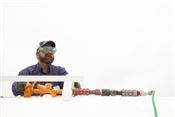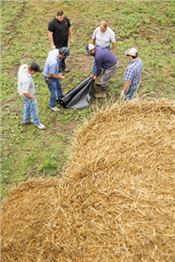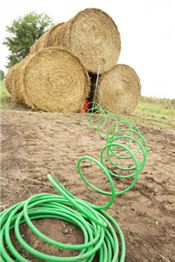Improve Low-Quality Forages With Ammonia Treatment
BELLFLOWER, MO.
Livestock producers can stretch short supplies of hay this year by using a simple ammonia treatment on bales, says University of Missouri Extension agronomist Rusty Lee.
Lee says ammoniation boosts the nutritive value of poor-quality hay and makes it more digestible for cows and horses. MU Extension state forage specialist Craig Roberts calls ammoniation a "secret weapon" in drought-stressed areas. With proper ammoniation, the nutritional value of hay, cornstalks and straw can improve significantly, even double, at a reasonable cost.
Lee says it is important to ammoniate only poor-quality hay. Higher-quality grass hay can become toxic with nitrates after ammonia treatment and cause “crazy cow” syndrome when fed. A maximum rate of 50 pounds of anhydrous ammonia per ton of straw should be observed to avoid nitrate issues.
Producers should not worry if their tall fescue is endophyte-infected before ammonia treatment, Roberts says. MU research shows that ammoniated tall fescue is about five times less toxic than pasture, as the toxins break down during ammoniation.
The process takes one week to a month, depending on temperature, says Lee. If the temperature is 85 degrees or higher, one week is recommended. Treat two to three weeks in milder temperatures and up to four weeks when temperatures fall. Lee says three weeks is a good average.
Follow these steps:
• Stack round bales in a pyramid so the covering will shed rainfall. Stack height is limited by width of plastic used to cover.
• Cover with 6 mil thick black plastic, the kind used to cover silage pits.
• Plastic sheeting should completely cover the stack with sufficient length to cover edges with soil or lime. Tamp soil down to create an airtight seal.
• Fill the ammonia tank with only the amount required for the stack being treated. This will avoid the risk of overtreating.
• Add ammonia slowly by cracking the valve on the tank. Let ammonia trickle into the middle of the hay bales overnight. Wear proper safety equipment when working around ammonia.
• Air out bales three days before feeding to allow the ammonia to clear. Do not uncover in windy weather. Air out before testing forage to check improvement.
Cost to ammoniate is $20-$30 per ton, depending on cost of plastic sheeting and ammonia in your area, Lee says.
For more information, contact Lee at 573-564-3733 or leerw@missouri.edu. You may also contact the agronomist at your county MU Extension center. ∆

MU Extension agronomist Rusty Lee adjusts the amount of anhydrous ammonia released from
a tank during a demonstration on ammoniating hay.

Presenters and attendees at a demonstration on ammoniating hay unravel the tarp that will cover the
hay during the ammoniation process. The tarp needs to be sealed so gas does not escape the haystack.

MU Extension agricultural business specialist Ken Bolte compacts dirt to seal a stack of hay
bales that will receive an ammonia treatment to improve the quality of the hay.

Before the haystack is covered and sealed, a tube is run from the ammonia tank
to a bucket in the stack.